Control allocation design for equal control sensitivity of tiltrotor aircraft
IF 5
1区 工程技术
Q1 ENGINEERING, AEROSPACE
引用次数: 0
Abstract
Control redundancy is a considerable challenge in tiltrotor aircraft, making an effective control allocation scheme critical for ensuring safe and smooth transitional flights. This study focuses on medium-to-large tiltrotor aircraft with fly-by-wire flight control systems and introduces an equal control sensitivity (ECS) allocation method based on ganging control (GC). This method aims to quantify and standardize the control allocation design process and accommodate various complex optimization objectives, including minimizing the control surface deflection angle, yaw-to-roll control coupling, and transient control loads on the nacelle tilt axis and rotor hub. The results show that the ECS allocation method specifically mitigates control coupling effects and transient peak responses in the nacelle tilt-axis and rotor hub moments while maintaining equal control sensitivity within the conversion corridor. In addition, the ECS allocation method has a significant advantage in reducing the variation range and dispersion of gain scheduling in feedback loops as it enables a smooth transition from helicopter mode to airplane mode using fixed control gains, while demonstrating good disturbance rejection capabilities. The ECS allocation method simplifies the workload of the feedback loop control gain design.
求助全文
约1分钟内获得全文
求助全文
来源期刊

Aerospace Science and Technology
工程技术-工程:宇航
CiteScore
10.30
自引率
28.60%
发文量
654
审稿时长
54 days
期刊介绍:
Aerospace Science and Technology publishes articles of outstanding scientific quality. Each article is reviewed by two referees. The journal welcomes papers from a wide range of countries. This journal publishes original papers, review articles and short communications related to all fields of aerospace research, fundamental and applied, potential applications of which are clearly related to:
• The design and the manufacture of aircraft, helicopters, missiles, launchers and satellites
• The control of their environment
• The study of various systems they are involved in, as supports or as targets.
Authors are invited to submit papers on new advances in the following topics to aerospace applications:
• Fluid dynamics
• Energetics and propulsion
• Materials and structures
• Flight mechanics
• Navigation, guidance and control
• Acoustics
• Optics
• Electromagnetism and radar
• Signal and image processing
• Information processing
• Data fusion
• Decision aid
• Human behaviour
• Robotics and intelligent systems
• Complex system engineering.
Etc.
 求助内容:
求助内容: 应助结果提醒方式:
应助结果提醒方式:


